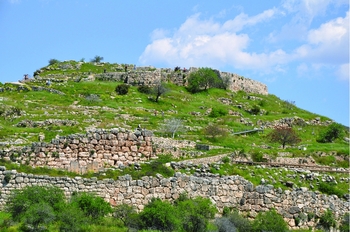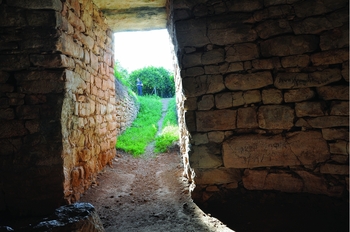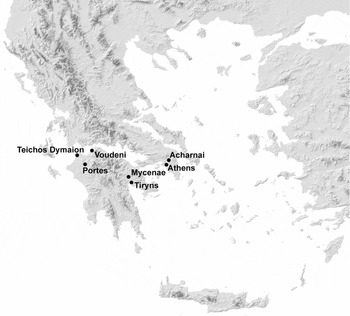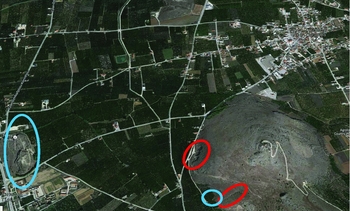Introduction
Mycenaean monumental architecture has been well studied. Yet the extent to which large-scale building programmes may have contributed to change and crises in Late Bronze Age Greece (c. 1600–1100/1070 BC) has never been investigated using actual field data. The aim of the SETinSTONE project is to assess if and how monumental building activities in Late Bronze Age Greece affected the political and socio-economic structures of Mycenaean polities, and how people may have responded to these changes (Brysbaert Reference Brysbaert2013).
Major building programmes took place across the Argive Plain and beyond from the sixteenth century BC onwards (especially in the thirteenth century), resulting in impressive citadels, burial monuments, waterworks, roads and bridges (Figures 1–3). These intensive and prolonged building programmes will have required significant human and material resources, and may have profoundly affected local subsistence economies. The potentially detrimental nature of the mobilisation of labour on this scale has been linked to the ‘collapse’ of the Mycenaean system (Shelmerdine Reference Shelmerdine1997: 566). Other factors linked to the Mycenaean collapse include climate change, the breakdown of inter-regional trade networks, drought, crop failure, natural disasters and warfare (Cline Reference Cline2014).

Figure 1. Mycenae, citadel, view from the south-west showing the massive stone walls.

Figure 2. Tiryns Tholos tomb, fifteenth century BC: view of the entrance from within the tholos chamber.

Figure 3. View from the south-east, overlooking the dromoi (rock-cut roads leading to entrance) of several Mycenaean tombs at Voudeni, Achaia.
Despite many attempts to explain the Mycenaean collapse and its extent, the complex interaction of many factors is still poorly understood. Indeed, the term ‘collapse’ itself is hotly debated (see Middleton Reference Middleton2010). Many of the indicators linked with Mycenaean collapse extended well beyond the Aegean. The Mycenaean polities were part of a wider Mediterranean system of interaction and interdependency. The hypothesis that massive building programmes led to the collapse of Mycenaean societies therefore needs to be evaluated in a much wider context than previously recognised. Most probably, each Mediterranean region experienced unique combinations of factors leading to social and economic crises.
SETinSTONE addresses the following questions:
-
1) What were the minimum levels of human and material resources required for prolonged building programmes (e.g. DeLaine Reference DeLaine1997; Brysbaert Reference Brysbaert2013, Reference Brysbaert2015)? Did these programmes affect or even deplete the available resources, and if so, to what degree?
-
2) What were the subsistence strategies during the centuries leading up to the Mycenaean collapse c. 1200 BC, and what resources were available in support of the building programmes?
-
3) If the use of labour for monumental construction did contribute to the Mycenaean collapse, how does this local phenomenon relate to societal crises in other regions of Greece and the Eastern Mediterranean that also suffered major setbacks, even though they did not undertake major building programmes?
The project's contribution
Some scholars argue that it is impossible to conduct a retrospective impact assessment of the Late Bronze Age building programmes of the Argive Plain because the available survey data are complex, uneven and incomplete. Our project holds a different opinion, arguing that such imperfect datasets are a constant for all archaeologists. The challenge, therefore, lies in comparing and triangulating disparate evidence in order to build multiple, independent datasets that, when combined, offer more than the sum of their parts.
By interweaving studies of landscape and material culture with fieldwork, the project contributes: 1) academically, by advancing our knowledge of the Late Bronze Age; 2) methodologically, by developing a multi-scalar and interdisciplinary approach to the study of prolonged building programmes and their effects on human ecology; and 3) socially, by understanding how social groups in the past may have dealt with multiple crises. By investigating cultural responses to changes in socio-economic and political structures, in environment and in access to resources, this project moves beyond specific issues pertaining to Aegean prehistory. By applying interdisciplinary approaches (e.g. DeLaine Reference DeLaine1997; Scheidel Reference Scheidel, Bellancourt-Valdher and Corvisier1999) in the demanding context of the Late Bronze Age Argive Plain, it will tackle questions about prehistoric demography, and challenge the view that only intensive survey data and epigraphic sources can provide insights on past demography (Scheidel Reference Scheidel, Bellancourt-Valdher and Corvisier1999).
Methodologies and fieldwork
Building processes (e.g. Küpper Reference Küpper1996) and social practices (e.g. Maran Reference Maran, Maran, Juwig and Thaler2006) are being assessed via an interdisciplinary methodology consisting of econometric (e.g. DeLaine Reference DeLaine1997), statistical, computer-based, anthropological and theoretical approaches. We collate a range of varied data on human ecology and past economies to illuminate the interconnected networks of human and resource interactions that affected people's day-to-day activities (e.g. Voutsaki et al. Reference Voutsaki, Milka, Triantaphyllou, Zerner, Voutsaki and Valamoti2013), and their wider economic, cultural and socio-political contexts.
Through intensive fieldwork, two PhD students and one post-doctoral researcher are investigating the chaînes opératoires of specific monumental building programmes in the core regions of the Argive Plain, Attica and Achaia (Figure 4). Another PhD student and post-doctoral researcher are studying the subsistence activities of past people in the Argive Plain (e.g. Bintliff Reference Bintliff1977; Simpson & Dickinson Reference Simpson and Dickinson1979; Wright Reference Wright, Alcock and Cherry2004; Fuchs Reference Fuchs2007), and collating varied datasets for the construction of GIS models. Through spatial analyses and the study of social space, a third post-doctoral researcher and the author are investigating human mobility in these landscapes (Figures 5–6; Brysbaert Reference Brysbaert2013, Reference Brysbaert2015). We are also investigating the physical and social impact of monumental building programmes on the local socio-economic and political structures of the Mycenaean world more widely, embedding the evidence of the Argive Plain within broader debates about societal collapse during the final phases of the Eastern Mediterranean Late Bronze Age (Maran Reference Maran2009; Cline Reference Cline2014).

Figure 4. Map of Greece indicating the sites of the project (Anavasis editions/Hans Birk; adapted by author).

Figure 5. Red- and grey-stone quarry zones (red circles) near Tiryns Tholos tomb (small blue circle) and citadel site (large blue circle) (original image © 2016 Google Maps, satellite view, adapted by author).

Figure 6. Abandoned red-stone quarry, north of Tiryns citadel, near the Agios Giorgios church (last date of use unknown but massive unworked boulders found nearby).
Acknowledgements
SETinSTONE is a team effort together with Yannick Boswinkel, Riia Timonen, Daniel Turner, Victor Klinkenberg, Hanna Stoeger and Elisa Siumpara. Fieldwork permissions have been obtained through the support of: E. Andrikou and the Ephorate of Antiquities of East Attica (Menidi); V. Petrakos at the Archaeological Society at Athens; J. Maran at Heidelberg University; A. Papadimitriou and the Ephorate of Antiquities of Argolida (Mycenae, Tiryns); L. Kolonas, M. Gazis and the Ephorate of Antiquities of Achaias (Voudeni, Portes, Teichos Dymaion); V. Elefteriou at the Acropolis Restoration Service and the Ephorate of Antiquities of Athens (Mycenaean Acropolis).
SETinSTONE is funded by an ERC Consolidator Grant (646777; 2015–2020) based at the Faculty of Archaeology, Leiden University. The project took shape in 2011 during discussions with J. Maran at Heidelberg University during a von Humboldt Senior Research Fellowship (2010–2013). Small-scale fieldwork and fieldschools at Tiryns (2013–2015) under the co-direction of Jari Pakkanen, director of the Finnish Institute at Athens, and research on architectural energetics and landscape archaeology were made possible with a Marie Curie—Gerda Henkel Senior Research Fellowship (2013–2015) at Leiden University.








